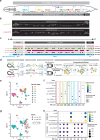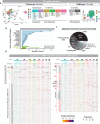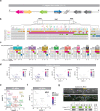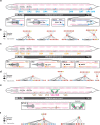This is a preprint.
A molecular atlas of adult C. elegans motor neurons reveals ancient diversity delineated by conserved transcription factor codes
- PMID: 37577463
- PMCID: PMC10418256
- DOI: 10.1101/2023.08.04.552048
A molecular atlas of adult C. elegans motor neurons reveals ancient diversity delineated by conserved transcription factor codes
Update in
-
A molecular atlas of adult C. elegans motor neurons reveals ancient diversity delineated by conserved transcription factor codes.Cell Rep. 2024 Mar 26;43(3):113857. doi: 10.1016/j.celrep.2024.113857. Epub 2024 Feb 29. Cell Rep. 2024. PMID: 38421866 Free PMC article.
Abstract
Motor neurons (MNs) constitute an ancient cell type targeted by multiple adult-onset diseases. It is therefore important to define the molecular makeup of adult MNs in animal models and extract organizing principles. Here, we generated a comprehensive molecular atlas of adult Caenorhabditis elegans MNs and a searchable database (http://celegans.spinalcordatlas.org). Single-cell RNA-sequencing of 13,200 cells revealed that ventral nerve cord MNs cluster into 29 molecularly distinct subclasses. All subclasses are delineated by unique expression codes of either neuropeptide or transcription factor gene families. Strikingly, we found that combinatorial codes of homeodomain transcription factor genes define adult MN diversity both in C. elegans and mice. Further, molecularly defined MN subclasses in C. elegans display distinct patterns of connectivity. Hence, our study couples the connectivity map of the C. elegans motor circuit with a molecular atlas of its constituent MNs, and uncovers organizing principles and conserved molecular codes of adult MN diversity.
Keywords: C. elegans; Hox genes; adult motor neurons; neuropeptides; scRNA-seq; transcription factors.
Conflict of interest statement
ETHICS DECLARATIONS The authors declare no competing interests.
Figures






References
Publication types
Grants and funding
LinkOut - more resources
Full Text Sources
